- Back to Home »
- Tourism »
- Tourism Objects of Aceh (Nangroe Aceh Darussalam) Province
3.07.2015
ACEH (NANGROE ACEH DARUSSALAM)
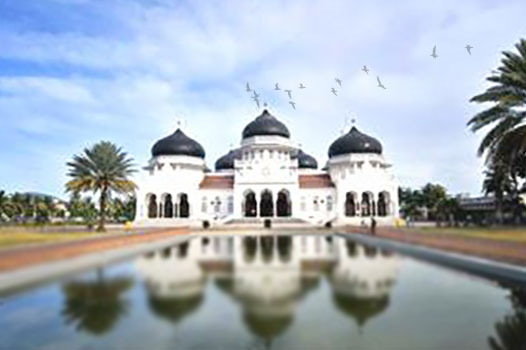
Aceh is rich of events, attraction and unique cultures that it will fascinate anyone. Aceh is also rich in natural beauty, waves and sea garden, which is suitable for diving. Some of most beautiful Aceh tourism and historical sites and beaches have been damaged by the massive earthquake and Dec '04 Tsunami. The name of Aceh Darussalam is come from Aceh language means the welfare and peace Aceh country.
Geographically
Geographically
Aceh is surrounded by:
North side: Malacca Strait
East Side: North Sumatra Province
South and the west Side: Indian Ocean.
The capital of Aceh is Banda Aceh. The Special Province of Aceh with its area of 57, 365.57 square kilometers covering 1.17 per cent of Indonesia is situated at the northern tip of Sumatra Island, between latitudes 2
North side: Malacca Strait
East Side: North Sumatra Province
South and the west Side: Indian Ocean.
The capital of Aceh is Banda Aceh. The Special Province of Aceh with its area of 57, 365.57 square kilometers covering 1.17 per cent of Indonesia is situated at the northern tip of Sumatra Island, between latitudes 2
In the central part of this province runs Bukit Barisan Mountain ranges with Tangse, Gayo, and Alas uplands. Also, there are several mountains found in the region such as Pasee Mountain with its peak, Geureudong" (2,595 m), and Peut Sagoe (2,708 m), Gayo Mountain range with its peak Burni Telong (2,566 m), and Ucap Malu Mountain range (3,187 m). Other mountains include: Alas mountain with its peak Abong-abong (3,015 m) Leuser (3,466 m), Aceh" Raya Mountain range with its peak Seulawah Agam, (1,762 m) and Seulawah Inong Mountain (868 m).
Tourism Objects
Mount Leuser National Park
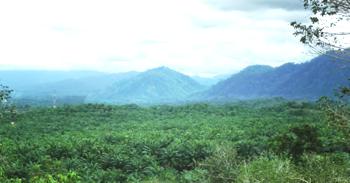
Mount Leuser National Park is one of the largest national parks in the world, containing over 800,000 hectares of virgin rainforest. The park is home to orangutans, gibbons, monkeys, elephants, tigers, and among the last of the Sumatran rhinoceros. There are research facilities for the study of primates, birds and insects, the Orangutans rehabilitation center at Bukit Lawang being the most popular with tourists. It is possible to raft Alas River from Ketambe to the Indian Ocean on a 4 - 5 day expedition. The journey takes us through exciting white-water rapids to the calmer, crocodile-infested waters of the lowlands. Basic accommodation is available at Ketambe.
The Leuser National Park of Gunung Leuser is probably the wildest in Indonesia, located in Southeast Aceh, can be reached from either Kutacane, or Takengon. This magnificent national park has a wealth of flora and fauna. The Leuser Ecosystem is an outstanding wilderness in Aceh northern Sumatra. It is one of the richest expanses of tropical rain forest in Southeast Asia. More than 2.5 million hectares in size, it is the last place on earth where elephants, rhinos, tigers, clouded leopards, and orangutans are found within one area.
The first official statement of intent to protect the Leuser Ecosystem was signed in 1934. The Leuser International Foundation (a non-profit non-government organization) was established in the late 1990's when the ecosystem was seriously under threat from illegal logging and wildlife poaching.
Geographically, the Leuser Ecosystem lies between 3-4.5° North and 96.5-98° East. It covers approximately 2.6 million hectares of tropical rain forest, encompassing 890,000 hectares of designated national park, as well as extensive areas of protection and production forests. The ecosystem contains two major volcanoes, three lakes, and nine major river systems that flow to the east and west coasts of the island.
The Leuser Ecosystem has an enormous level of biodiversity. It contains at least 127 mammal species, including the Sumatran elephant, Sumatran tiger, Sumatran rhinoceros, and Sumatran orangutan. About 8,500 different plant species grow in the beach, swamp, lowland, mountain and alpine ecosystems of the Leuser Ecosystem. Of the 10,000 plant species recorded in the West Indo-Malayan Region, 45% are found in the Leuser Ecosystem. Spectacular plants such as Rafflesia (the largest flower in the world) and Amorphophallus (the tallest flower in the world) are among the plants protected there.
Mount Leuser National Park is one of the biggest national parks in Indonesia (950,000 hectare). Actually, it's a collection of various nature reserves and forests: Nature Reserve Mount Leuser, Nature Reserve Kappi, Nature Reserve Kluet, Sikundur Langkat Wildlife Reserve, Ketambe Research Station, Singkil Barat and Dolok Sembilin. Most parts of the national park lie in the region Aceh Tenggara (SE Aceh). Other parts are situated in the region east Aceh, south Aceh, and Langkat.
Mount Leuser National Park comprises more than 100 kilometers of the Bukit Barisan Mountains. Because of that, the park consists of steep, almost inaccessible mountainous terrain. The altitude ranges from 0 meter, in Kluet (South Aceh), to 3,381 meter, on top of the mount Leuser (Southeast Aceh). The Alas River cuts the park into an eastern and western half. Apart from mountains we find several other ecosystems: beach forest, swamp areas, lowland rainforest, alpine and mountain forest. In Bukit Lawang is the Orang Utan Rehabilitation Station and in Ketambe stands the Ketambe research station.
Museum Negeri
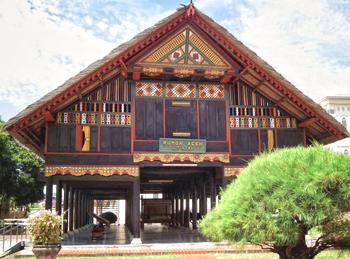
There is a museum in Banda Aceh located near the Governor's residence. The main building of the Museum is a house built in a traditional style by the Dutch Governor Van Swart in 1914. The museum has 3 floors filled with antique weapons, gold jewelry, ceremonial costumes and household furnishings. The 'Rumah Aceh' is an excellent example of traditional architecture, built completely without nails, being held together by cord and pegs. Among the exhibits is a big clock Cakra Donya, a gift from China Emperor and brought to Aceh by the famed Admiral Cheng Ho in 1414. On the bell can be found a Chinese script, Sing Fang Niat Toeng Juut Kat, no one knows what it really means.
Glen Labuhan Guest House (Monkey Beach)
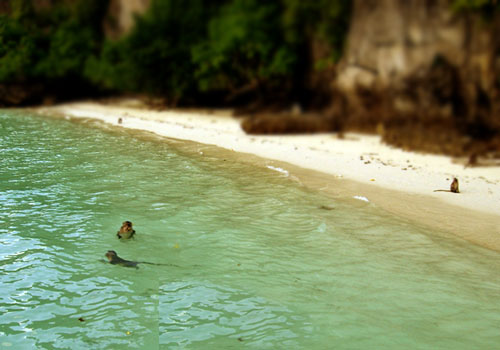
Glen Labuhan beach Guest House (Monkey beach) is situated between two jungle covered mountains comprising a sheltered 120 m length of beach, with dense rain forest and lake immediately behind. Some 80 % of the bay is coral rock, the home of uncountable tropical fish. The Northern end of the beach is sand, suitable for swimming out and snorkeling behind the coral. The beach has long been favorite picnic site of expatriates working in parts of Sumatra. The Guest House is on the Beach (within 15 meters of high water line), and overlooks the shoreline trees to islands of Northern tip of Sumatra. It is a first class private Guesthouse with family accommodations in a tropical paradise. Alternative accommodation (for Tarzan enthusiasts) is tree house, some few meters a long beach. All meals are inclusive.
Pinto Khop
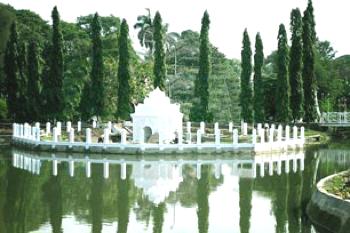
Pinto Khop is building a door that was built in the reign of Sultan Iskandar Muda, Pinto Khop is a connecting door between the Palace and Park Putroe Phang. Khop Pinto is a dome-shaped gate. The door is a place to rest Khop Princess Phang, after tired to swim, not far from the structure's history, there the lady's maid to wash your hair the consort. There are also a pool for the consort flower bath. Also on the ground by the Emperor built a library and became the consort and the Sultan's place to spend time with a book after swimming, shampooing and bathing interest.
Pinto Khop, which is located at a few steps from the Pendopo, are also charms of the city. Gunongan was erected around the 16th century during the reign of Sultan Iskandar Muda.
Kerkhof
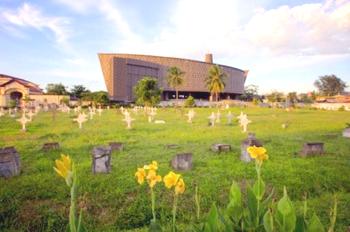
The cemetery here holds the remains of over 2,000 Dutch, Eurasian, Javanese and Ambonese soldiers who died fighting in the Aceh Wars. Kerkhof or Churchyard is a much-visited site especially by Dutch visitors where the remains of more then 2,000 Dutch soldiers lie buried. About 2,200 soldiers were buried in this graveyard including the General Kohler. Their names, where and when they died can seen at the gateway to the Kerkoff.
Cut Nyak Dhien House
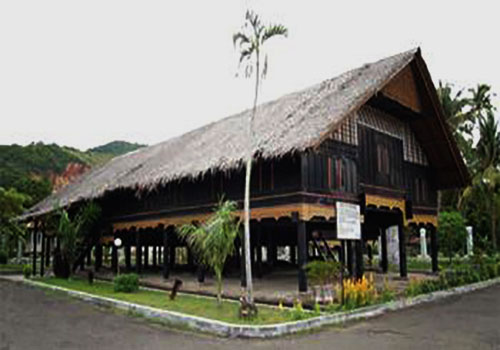
The house is a replica of the heroine Cut Nyak Dhien House, from the Aceh War. The colonial forces burned down the house but a replica was built later. This house in Lam Pisang, about 6 kilometers from Banda Aceh, now is a museum. The house is located in Lampisang Village, Lhok Nga subdistrict, Greater Aceh district. Although Lhok Nga was the area worst hit by tsunami, the Tjut Nyak Dhien House survived. The daughter of a chieftain, Tjut Nyak Dhien joined the fight against the Dutch invaders in 1875. Her first husband fell in battle, and she remarried. When her second husband also died fighting, she continued the struggle with her children. After six years in the jungle, she was captured by the Dutch and exiled to West Java where she passed away in 1906. Tjut Nyak Dhien is recognized as one of the National Warriors of Indonesia.
Indra Patra Fortress
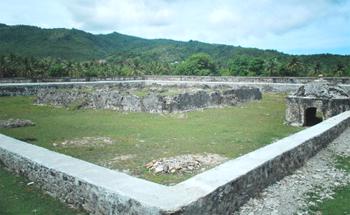
This old fort was built during Iskandar Muda time. It probably functioned as a defense against invaders. (Damaged because of Tsunami)
Indra Patra Fortress was built during the pre-Islamic, by the King of the Kingdom Lamuri which is a Hindu Kingdom First in Aceh, precisely at the VII century AD.
Currently, only two of the three forts are still standing strong. Main Fortress measuring 70m X 70m; with a height of 4 meters and a wall thickness of approximately 2 meters. Unique architecture, Large, made of "limestone concrete" (: mountain stone structure, with glue (estimate) of a mixture of lime, Clay, and alusan Leather Shell, as well as eggs).
In the Main fort there are two 'stupas' or a building that resembles a dome where inside / under the dome there are wells / water sources, which (at the time) used by Hindus for ablutions in the series peribadahannya. In addition, there is also a bunker inside the fort for storing guns and bunkers to save bullets and guns.
Around Lhokseumawe
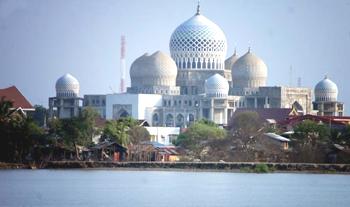
Lhokseumawe is a town located 274 km from Banda Aceh, which is now being developed, as an industrial zone. Many gigantic plants are constructed following the discovery of huge LNG resources in the area. The touristy feature of the town is i.e. Samudera Pasai. It was the first great Islamic kingdom of Indonesia. All that remains of it, however, is a graveyard 18 km east of the town. One of the graves belongs to Malikussaleh, as Samudera Pasai's first king. Other objects for visitors are Blang Kolam Falls and Ujung Blang beach.
Takengon
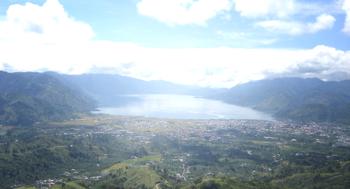
Takengon is a town located in the central area of Aceh. It is being promoted as a tourist resort since its temperature is about 2O degree C (68F), cool enough for a holiday resort. The main feature of the town is Laut Tawar Lake. It offers soaring cliffs around the shore, which are ideal for rock hiking. The lake is also stocked with trout. It is a pleasantly cool holiday resort, at an altitude of 1,200 meters above sea level. Central Aceh is one of Sumatra's foremost producers of high quality coffee. A warm water pool at Simpang Balik, Loyang Koro and Loyang Pukes caves by the side of Laut Tawar are also interesting objects.
Baiturrahman Mosque

Sitting in a vast expanse of green fields, the white washed walls and minerals, and charcoal blacks domes of the Grand Mosque are the most famous landmark in Aceh. The Great of Baiturrahman Mosque is the main feature of Banda Aceh today. Lying at the heart of the city completed with excellent architectural style, this mosque is really one of Indonesia prime tourism sides. The Mosque was built in 12 Century and had caught fire several time include when the Dutch attacked Kutaraja (Banda Aceh) in 1873. Another mosque to replace the former one was later built by Dutch Military Government that was completed in 1883. The Mosque is extra ordinary in architecture and ornamentation. It has five onion shaped domes, two tall mine rates, wide white walls, and around is pillars various kinds of beautiful ornament.
Gunongan - Gunongan
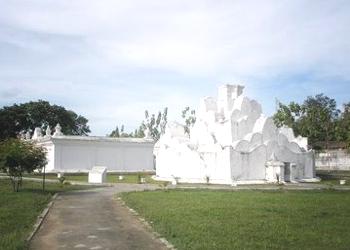
Gunongan had erected by Sultan Iskandar Muda (1607 - 36) as a private playground and bathing place for this wife Putro Phang (From Malaysia). This whimsical architectural fantasy had access to the sultan's palace through the traditional 'Pintu Aceh', used by royalty only. This building likely functioned as an important recreational peace located in the Taman Sari Park for the Queen and other royal family members to climb. It is quite enjoyable to visit this place during the late afternoon or sunset.
Structure's history and power of love is a symbol of the Sultan Iskandar Muda to the beautiful queen, Princess Phang (Phang Putroe) derived from Pahang, Malaysia. Once, Putroe Phang often feel lonely in the middle of the husband as head of government. He always remembered by his hometown in Pahang. The husband understand the anxiety empress. To please the empress, he built a small mountain (structure's history) as a miniature hills that surround the palace Putroe Phang in Pahang.
Once the structure's history is built, how happy the consort. Spent his days playing with a lot of ladies in waiting around structure's history, as he climbed up. Structure's history is located at Jalan Teuku Umara dealing with the location of graveyard Dutch soldiers (Kerkoff). The building was founded in the reign of Sultan Iskandar Muda (1607-1636) in the 17th century.
Building structure's history is not too large, hexagonal, shaped like a flower and a three-story with main level of a crown pillar that stands upright. On the walls there is a low-sized entrance which is always in a locked state. From the hallway door is a staircase leading to third level structure's history.
The Monument RI.001 Seulawah
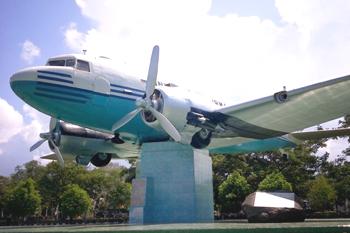
The Monument was erected to commemorate the heroic donation of the Acehnese to the central Government of the Republic of Indonesia became independent in 1945, the Dutch intended to reoccupy the country. In the ensuring struggle in 1949, the Republic of Indonesia was badly in need of an airplane to open the blockade of the enemy as much area had been already fallen into their hands. Mr. Soekarno, the president of the Indonesia at that time.
Urgently requested that Aceh people to donate the money for an airplane. A Douglas DC-3 was bought shortly afterwards, and paid for with Acehnese Gold. This very early plane was the precursor of Garuda Indonesia fleet, which nowadays is the biggest airline in Indonesia.
Alas River

Alas River, 165 km southeast from Takengon, cuts through Mount Leuser National Park. This area is especially popular among the young and adventurous. The sharp bends and many rapids are challenging to white-water rafters.
The Governor's Residence
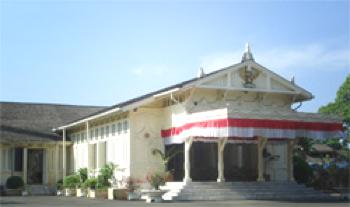
This Governor's Residence building has built by the Dutch in 1880 on the spot where the palace of the sultan once stood. This building is known as one of the historical sites with a unique architecture and completed with traditional house equipments.
Laut Tawar Lake
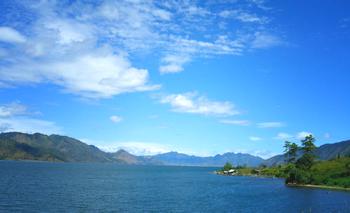
Laut Tawar Lake is located near Takengon, in the highlands of Cental Aceh, is very scenic. Takengon, the capital of the region, lies on the west side of the lake, 1,120 meters above sea level, with an average temperature of 20 C. It has soaring cliffs around the shore, which are ideal for rock climbing. The scenery is lovely and the area is being developed as a tourist resort with water recreation such as skiing and boating being readily available. The lake is also stocked with trout. There are warm water pools at Simpang Balik. Many caves dot the lake's surroundings, Loyang Koro and Loyang Pukes caves by the side of Laut Tawar Lake are interesting to explore. Motorboats can be hired for fishing and sightseeing. There is excellent hiking in forests filled with exotic orchids, and trekking to the Telong and Tetek volcanoes for the more energetic.
Syiah Kuala Grave
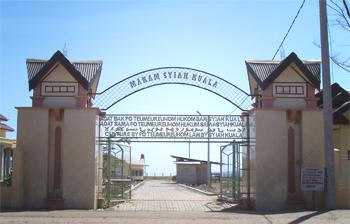
Syiah Kuala grave is another pride of Banda Aceh, which is located about 3 km to the east. It stands near the mouth of Krueng Aceh River, about 2 kilometers from the city. Syiah Kuala was one of Aceh's great Moslem Ulama of the past. He had spent more than 15 years in Mecca for religious learning before he dedicated most of his life to science and society. He had written many books on Islam, social studies, and science. He also had a lot of student coming from Malaysia, West Sumatra and Java. His grave is a shrine for local visitors and Muslims from Indonesia and Malaysia. (Mostly destroyed because of Tsunami)
Ulee Lheue
Ulee lheue is an old port where one can see many typical villages that stay surrounding area. There is also beach, which is visited regularly by local people early every Sunday morning. The beach is also popular for fishing on holiday. (Mostly destroyed by Dec '04 Tsunami and over 85% of its population killed).
Beaches
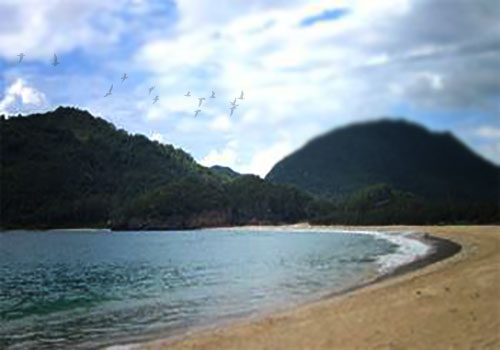
Lhok Nga is a great beach for picnicking. Ujung Bate is a black sand beach nice for walking and collecting seashells. For swimming the best is the exquisite white sand beach at Lampu'uk. Remember to dress appropriately, local women swim fully clothed.
Weh boasts a wide variety of beaches waiting to be explored by visitor. Kasih Beach (Love Beach) is the nearest beach to the town of Sabang. About 2 km to the southwest lays a rocky beach with over hanging palm trees stretching the length of the peninsula. Along this northern peninsula we will find World War II gun emplacements. Some have decayed while others have remained intact. Following the coast two kilometers further will lead us to Tapak Gajah Beach (Elephant Step Beach). If we go on, we will reach Sumur Tiga Beach (Three Well Beach). This is generally considered to be Weh's most beautiful beach. Its soft white sand and crystal clear water make it an ideal place to swim and snorkel.
Rubiah Sea Garden
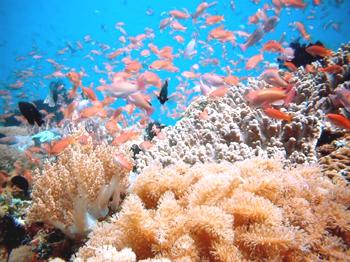
Rubiah Sea Garden is situated about 23.5 km west of Sabang by road, or about 7 km by boat, adjacent to Iboih village. The Indonesian Government has established this water area of 2600 hectares around Rubiah Island as a special nature reserve. Being located in Sabang bay the waters here are calm and crystal clear too (25 m visibility) the sea here abounds with an incredible variety of colorful tropical fish and coral reefs. We can find gigantic clams, angelfish, school of parrotfish, lionfish, sea fans, and much more.
For experienced snorkeling, Octopus and Stingrays (not dangerous to observer) are sure sightings here. Try viewing the coral from glass bottom boat. Sunbathe or stroll on the remote white sand beaches of the adjacent shores. Undoubtedly, one of the best-kept secrets in the world of tourism is a paradise for snorkeling and scuba diving. The distance to the coral is only 5 m from the shore. For those who just cannot get themselves to leave this spot, accommodation and meals are available from the villagers of Iboih upon request.
Iboih Recreational Forest
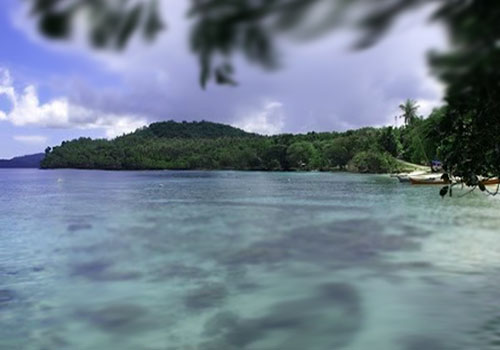
Iboih is a small and friendly village. Its people will happily serve the tourist in any way. In a place where the tourist come one by one, the people here have retained their sense of curiosity towards westerners. Helpful guides are available to accompany the tourists to Iboih and the Sea Garden.
Iboih Recreational Forest is situated adjacent to Rubiah Sea Garden. This forest covers about 1300 hectares area and is also protected as a special nature reserve for Weh Island. This forest is a thick tropical rain forest and although it is dense a difficult to wander trough, visitors are encouraged to explore it. This are is as home to many kinds of animals. See wild monkeys, small and big reptiles and colorful birds, or try our skill at spotting the Nicobar pigeon, not found in any other part of the Indonesian archipelago. At dusk wild boars and swarms of giant fruit bastes are sure sighting. Where the road ends is a great lookout over the Indian Ocean.
Boiling Mud
Cot Simeureugoh (547 m mill) is 17 km from the town. This semi-active volcano holds boiling water in its caldera and occasionally emits smoke. Also located near Iboih village, is a small volcano with its well of boiling mud. We can hike up the side of this small volcano to the well and look down into it. This volcano is semi-active; the crater holds boiling mud and occasionally emits gases and billowing smoke. Weh also contains several hot water springs at various locations, which remain in their natural state. Ask about them in Sabang or Iboih.
Coastal Caves
There are several natural caves located along the west coast of Weh adjacent to Iboih Recreational Forest. The caves faced the ocean and are inhibited by various kinds of birds, bats, and snakes. Explore these water caves by boat, but only with a local guide who knows them very well. Access to these caves may be difficult during the west monsoons season (May - September).
Japanese And Dutch Fortresses of World War II
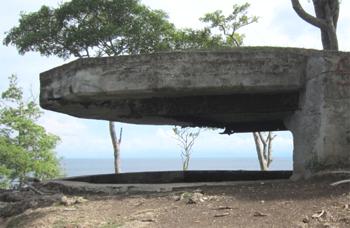
During World War II Weh was fought over for its strategic location at the mouth of Malacca strait. At first Sabang was used as the head quarter by the Dutch. But then in March 1943, the Javanese took Sabang and forced the Dutch out of the island. As a result there are many Dutch and Javanese made fortresses to be found on Weh. Some fortresses have been built above ground while others below. Some are located on hilltops or hillside overlooking the sea and are ideal places from which to enjoy the beautiful scenery.











